
Oct . 31, 2024 17:03
Back to list
Understanding the Importance and Functionality of Relief Valves in Various Applications
Understanding Relief Valves Essential Safety Devices in Industrial Systems
Relief valves play a crucial role in maintaining the safety and efficiency of various industrial systems. These devices are designed to automatically release excess pressure from vessels or pipelines to prevent catastrophic failures. In many industries, such as oil and gas, chemical processing, and power generation, the importance of relief valves cannot be overstated.
At its core, a relief valve functions by opening at a predetermined pressure level, allowing fluids (liquids or gases) to escape and thus reducing overall pressure within the system. This automatic response is vital in preventing pressure buildup that could lead to equipment damage, structural failure, or hazardous accidents. The operation of relief valves is not only a safety measure but is also integral to regulatory compliance in many sectors.
There are several types of relief valves, but the most common are spring-loaded and pilot-operated valves. Spring-loaded relief valves are straightforward; they use a spring mechanism to hold the valve closed until the pressure exceeds a certain threshold. When this threshold is surpassed, the spring compresses, allowing fluid to escape. Pilot-operated relief valves, on the other hand, utilize a secondary mechanism called a pilot to control the larger valve. This type generally provides better performance in systems with fluctuating pressures.
relief valves

The selection of a relief valve requires careful consideration of various factors, including the specific application, fluid type, temperature, and pressure requirements. Engineers must ensure that the selected relief valve meets the proper sizing, which is critical to its effective operation. An undersized valve may not discharge enough fluid to relieve pressure, while an oversized valve may open too frequently, causing operational inefficiencies.
Regular maintenance and testing of relief valves are imperative to ensure their functionality. Over time, elements such as corrosion, debris buildup, or wear and tear can impair their ability to operate correctly. Therefore, many industries implement routine inspections, testing procedures, and maintenance schedules to ensure that these safety devices perform effectively. This proactive approach not only enhances safety but also contributes to the overall reliability of industrial operations.
In conclusion, relief valves are indispensable safety devices that safeguard industrial systems from excessive pressure. Understanding their function, types, and maintenance requirements is essential for engineers and operators to ensure the safety and efficiency of their operations. As industries continue to evolve, the importance of effective pressure management through devices like relief valves will undoubtedly remain a critical component of operational safety and regulatory compliance.
Latest news
-
Safety Valve Spring-Loaded Design Overpressure ProtectionNewsJul.25,2025
-
Precision Voltage Regulator AC5 Accuracy Grade PerformanceNewsJul.25,2025
-
Natural Gas Pressure Regulating Skid Industrial Pipeline ApplicationsNewsJul.25,2025
-
Natural Gas Filter Stainless Steel Mesh Element DesignNewsJul.25,2025
-
Gas Pressure Regulator Valve Direct-Acting Spring-Loaded DesignNewsJul.25,2025
-
Decompression Equipment Multi-Stage Heat Exchange System DesignNewsJul.25,2025

